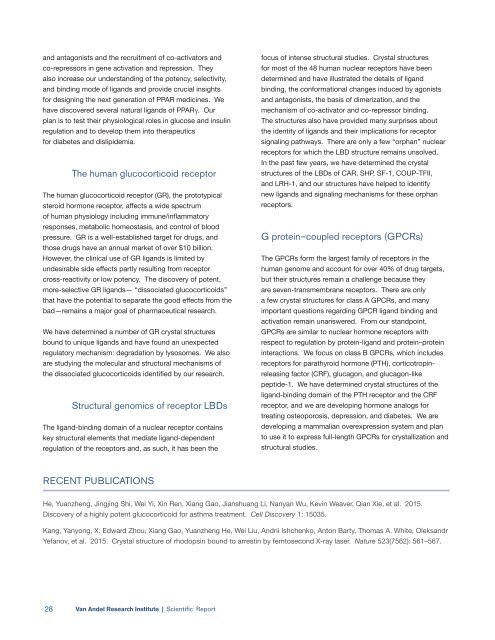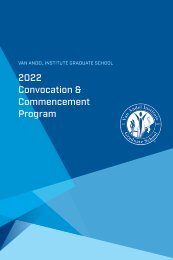2016 Scientific Report
You also want an ePaper? Increase the reach of your titles
YUMPU automatically turns print PDFs into web optimized ePapers that Google loves.
and antagonists and the recruitment of co-activators and<br />
co-repressors in gene activation and repression. They<br />
also increase our understanding of the potency, selectivity,<br />
and binding mode of ligands and provide crucial insights<br />
for designing the next generation of PPAR medicines. We<br />
have discovered several natural ligands of PPARγ. Our<br />
plan is to test their physiological roles in glucose and insulin<br />
regulation and to develop them into therapeutics<br />
for diabetes and dislipidemia.<br />
The human glucocorticoid receptor<br />
The human glucocorticoid receptor (GR), the prototypical<br />
steroid hormone receptor, affects a wide spectrum<br />
of human physiology including immune/inflammatory<br />
responses, metabolic homeostasis, and control of blood<br />
pressure. GR is a well-established target for drugs, and<br />
those drugs have an annual market of over $10 billion.<br />
However, the clinical use of GR ligands is limited by<br />
undesirable side effects partly resulting from receptor<br />
cross-reactivity or low potency. The discovery of potent,<br />
more-selective GR ligands— “dissociated glucocorticoids”<br />
that have the potential to separate the good effects from the<br />
bad—remains a major goal of pharmaceutical research.<br />
We have determined a number of GR crystal structures<br />
bound to unique ligands and have found an unexpected<br />
regulatory mechanism: degradation by lysosomes. We also<br />
are studying the molecular and structural mechanisms of<br />
the dissociated glucocorticoids identified by our research.<br />
Structural genomics of receptor LBDs<br />
The ligand-binding domain of a nuclear receptor contains<br />
key structural elements that mediate ligand-dependent<br />
regulation of the receptors and, as such, it has been the<br />
focus of intense structural studies. Crystal structures<br />
for most of the 48 human nuclear receptors have been<br />
determined and have illustrated the details of ligand<br />
binding, the conformational changes induced by agonists<br />
and antagonists, the basis of dimerization, and the<br />
mechanism of co-activator and co-repressor binding.<br />
The structures also have provided many surprises about<br />
the identity of ligands and their implications for receptor<br />
signaling pathways. There are only a few “orphan” nuclear<br />
receptors for which the LBD structure remains unsolved.<br />
In the past few years, we have determined the crystal<br />
structures of the LBDs of CAR, SHP, SF-1, COUP-TFII,<br />
and LRH-1, and our structures have helped to identify<br />
new ligands and signaling mechanisms for these orphan<br />
receptors.<br />
G protein–coupled receptors (GPCRs)<br />
The GPCRs form the largest family of receptors in the<br />
human genome and account for over 40% of drug targets,<br />
but their structures remain a challenge because they<br />
are seven-transmembrane receptors. There are only<br />
a few crystal structures for class A GPCRs, and many<br />
important questions regarding GPCR ligand binding and<br />
activation remain unanswered. From our standpoint,<br />
GPCRs are similar to nuclear hormone receptors with<br />
respect to regulation by protein-ligand and protein–protein<br />
interactions. We focus on class B GPCRs, which includes<br />
receptors for parathyroid hormone (PTH), corticotropinreleasing<br />
factor (CRF), glucagon, and glucagon-like<br />
peptide-1. We have determined crystal structures of the<br />
ligand-binding domain of the PTH receptor and the CRF<br />
receptor, and we are developing hormone analogs for<br />
treating osteoporosis, depression, and diabetes. We are<br />
developing a mammalian overexpression system and plan<br />
to use it to express full-length GPCRs for crystallization and<br />
structural studies.<br />
RECENT PUBLICATIONS<br />
He, Yuanzheng, Jingjing Shi, Wei Yi, Xin Ren, Xiang Gao, Jianshuang Li, Nanyan Wu, Kevin Weaver, Qian Xie, et al. 2015.<br />
Discovery of a highly potent glucocorticoid for asthma treatment. Cell Discovery 1: 15035.<br />
Kang, Yanyong, X. Edward Zhou, Xiang Gao, Yuanzheng He, Wei Liu, Andrii Ishchenko, Anton Barty, Thomas A. White, Oleksandr<br />
Yefanov, et al. 2015. Crystal structure of rhodopsin bound to arrestin by femtosecond X-ray laser. Nature 523(7562): 561–567.<br />
28 Van Andel Research Institute | <strong>Scientific</strong> <strong>Report</strong>

















